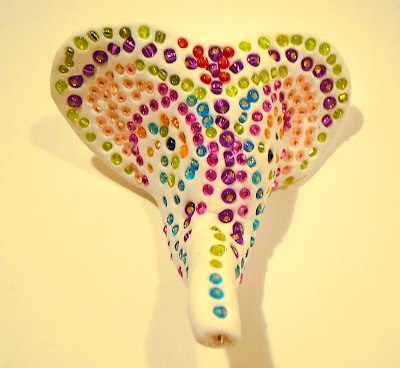A few days ago, someone mentioned Huichol art, and I remembered that I had a similar clay-resin figure from childhood. Mine is East Indian, and it has far fewer beads than Huichol art, but the idea is more or less the same. Not that I'd call today's elephant proper Huichol anything, but it's at least inspired by the technique.
 |
| My little Indian beaded clay elephant. |
The Huichol are an indigenous people living in the mountains of north-central Mexico. Numbering about 50,000 today, they are perhaps best known for their colourful works of art. The most iconic and commercially successful forms of Huichol art are yarn "paintings" and three-dimensional objects decorated with seed beads.
The beads are embedded into forms coated with a mixture of wax and resin. The beads are tightly packed across the surface, forming highly colourful and often abstract patterns. Although glass and plastic beads are commonly used today, long before the advent of western beads, the Huichol were producing similar works using beads made of bone, stone, coral, clay, jade, seeds, pyrite, clay and turquoise.
 |
| Huichol jaguar head, covered in seed beads. Source: http://pattihaskins.wordpress.com/category/mexican-folk-art/ |
The traditional patterns featured in Huichol art have been used for centuries. Originally intended to represent and communicate with the gods, Huichol designs have evolved in response to the availability of modern materials, becoming more elaborate, more colourful, and less traditional. Huichol art has also become more commercial, produced less for religious purposes than as a source of income.
Modern Huichol beaded items are often inspired by yarn paintings. Yarn paintings depicting visions and other spiritual experiences were the first form of Huichol art to come to the attention of galleries. As artists began experimenting with materials, there was renewed interest in the use of beads, albeit with brighter colours. Today, beads are commonly used instead of yarn by many Huichol artisans, although the beaded patterns often mimic lines of yarn.
 |
| Modern Huichol yarn painting. Source: http://people.tribe.net/gael |
One of the most interesting forms of Huichol art is the kuka: a three-dimensional ceremonial mask covered in beads. These masks evolved from small gourd bowls, which were covered in traditional materials such seeds, bone, shell, clay and coral—since replaced with commercial beads. The modern practice of covering wooden forms such as dolls, animals and jaguar heads with beads derives from the kuka.
Although much Huichol art is produced for the tourist market, many items are still produced for ceremonial use, and as fine art. In recent years, there have been several international exhibitions of Huichol art, as well as large-scale bead murals and other commissions for buildings around the world.
For today's elephant, I used an air-dry clay that I got for a dollar. I chose this stuff because it was soft and pliable, and because it came in a nice, bright white.
I started by making an elephant head, as a bow to the masks that are common to Huichol art.
Once I was happy with the shape, I started sticking glass seed beads into it. The clay is a bit weird, in that it feels like a sticky, spongy vinyl. As long as it was damp, however, it accepted the beads reasonably well.
As the clay began to dry, it was less friendly to the beads. They began popping off if I squeezed even a little in one spot or other. Sometimes they refused to stick at all—except to my fingers. Then it occurred to me that, if I dampened it slightly, the clay sort of reactivated, and the beads stuck well.
To a certain extent, I think this would have been a bit easier if I'd had something as sticky as beeswax and resin blended together, but the air-dry clay was okay in the end.
I didn't have time to embed the entire shape with beads, but I was pretty happy with how far I got. I felt as though it would start to look weird if I added any more beads to this particular shape, so I stopped myself without filling every blank space. This took me about two hours, so that was kind of enough time to spend on it as well. I may varnish it at some point to make sure the beads stay put, but for now it's fine as is.
I was surprised at how pretty this was when I was finished. It has far more beads than my little Indian clay elephant, so I guess I didn't do too badly. It can't really claim to be proper Huichol work—since it isn't fully covered, and isn't a wooden form coated in beeswax and resin—but I'm quite happy with the final result, and may even try it again sometime. In fact, I may even try true Huichol art, when it isn't something I have to complete within a short space of time.
Elephant Lore of the Day
In the 1920s, elephant keeper Henry Sheak was working with a circus that had several elephants. Twice a day, he fed the herd a tasty mixture of bran and oats, in addition to their usual hay. The mixture was placed between each pair of elephants for them to share.
Tillie and Queenie, the two largest members of the herd, always stood together. Tillie was particularly good about dividing the pile of food exactly in half, pulling her share closer to herself as soon as it was divided. However, although Tillie divided the food fairly, as soon as Queenie looked the other way, Tillie was not above reaching over and snatching an extra trunkful of Queenie's food for herself, adding it quietly to her own pile.
 | |
| Elephants at Prague Zoo, Czech Republic, 2011. Photo: AFP/Michal Cizek Source: http://aussie55.livejournal.com/881295.html |
To Support Elephant Welfare
Elephant sanctuaries
(this Wikipedia list allows you to click through to information
on a number of sanctuaries around the world)
Wildlife Trust of India









No comments:
Post a Comment